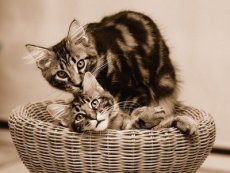Cats of wool in the stomach of cats
Last reviewed: 23.04.2024

All iLive content is medically reviewed or fact checked to ensure as much factual accuracy as possible.
We have strict sourcing guidelines and only link to reputable media sites, academic research institutions and, whenever possible, medically peer reviewed studies. Note that the numbers in parentheses ([1], [2], etc.) are clickable links to these studies.
If you feel that any of our content is inaccurate, out-of-date, or otherwise questionable, please select it and press Ctrl + Enter.

Undoubtedly, lumps of wool in the stomach in cats - an unpleasant phenomenon. This is not just unpleasant for the person who removes them. They can cause clogging of the intestines, which can seriously damage your cat's health. If your cat itself takes care of the hair, what can you do to reduce the formation of lumps in the stomach to a minimum?

What causes the formation of clumps of wool in the stomach in cats?
Wool combs, which are formally called Trichobezoars, can be disgusting, especially on your white rug, but they are formed as a result of your cat's healthy and scrupulous care of itself.
When the cat is washing, small formations in her tongue that resemble hooks capture the fallen and dead hairs that are then swallowed. Most of these hairs pass unhindered through the digestive tract. But if the hairs remain in the stomach, they can form a wad of wool. In the end, the cat regurgitates a wad of wool to get rid of it. Since wool lumps on the way out pass through a narrow esophagus, they are often thin and tubular, and not round.
Wool coats are more likely to form in long-haired breeds, such as Persians and Maine Coons. Cats that strongly molt or obsessively lick themselves, are also more prone to the formation of lumps of wool, because they swallow a lot of wool. Perhaps you noticed that when your cat was a kitten, she did not have lumps of wool, but they appeared when she grew up. It's perfectly normal - as the cat grows older, it's better to take care of the hair and therefore more carefully remove the hairs with the help of the tongue. This means that you have to remove more lumps of wool.
Symptoms of wool in the stomach in cats
It can be disgusting to watch (and hear) a cat regurgitating a wad of wool. Common symptoms include coughing, vomiting and vomiting. Then usually a cat regurgitates a wad of wool relatively quickly.
If you notice the following symptoms of the presence of lumps of wool, be sure to contact the veterinarian, as they can say that the lump caused clogging, potentially life-threatening:
- Continuous vomiting, vomiting or coughing, in which a lump of wool does not come out
- Lack of appetite
- Drowsiness
- Constipation
- Diarrhea
Four funds from lumps of wool
It is impossible to do something to completely prevent the formation of lumps of wool in the stomach in cats, but you can reduce the likelihood or frequency of their formation.
- Regularly comb the cat hair. The more wool you brush, the less it will remain as a starting material for the formation of lumps in the stomach. Daily combing of hair with a comb or brush can be effective in reducing the amount of lumps, and it is also a pleasant way to communicate with a cat. If you can not train a cat to care for wool or combing, think about contacting a hairdresser and haircut specialist (especially for longhair cats) every six months or so.
- Give the cat a special food designed to reduce lumps of wool. Many manufacturers of pet food now produce cat food to reduce the amount of wool. Such compounds with a high content of fiber are designed to improve the health of the cat's fur, reduce hair loss and facilitate the passage of lumps in the digestive system.
- Use a remedy for lumps of wool or a laxative. Today in the market there are a number of different products from wool clots, most of them are soft laxatives that help lumps pass through the digestive tract.
- Prevent excessive care of the coat. If you suspect that the lumps of hair in your cat are formed as a result of obsessive licking of the hair, try to teach the cat another pleasant lesson. You can teach her to play alone with a new toy, or find a funny toy that you can play together.
